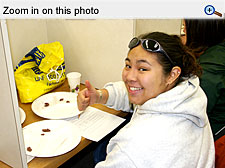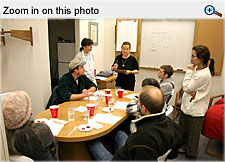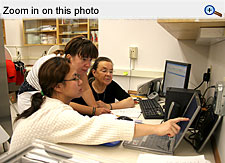Thumbs-up to reindeer meat samples

A volunteer taste tester gives the thumbs up sign during a roasted reindeer meat tenderness
test at the Cooperative Extension Service Building on the UAF campus in Fairbanks.

Visiting Swedish sensory panel expert Lisbeth Johansson (center, standing), School
of Natural Resources and Agricultural Sciences research faculty member Eva Wiklund
(standing in striped shirt) and CES food research technician Kamolluck Trateng (standing,
right) train a group of sensory panelists on the subtleties of taste-testing reindeer
meat at the Cooperative Extension Service Building on the UAF campus in Fairbanks.

Cooperative Extension Service food research technician Kamolluck Trateng (left), School
of Natural Resources and Agricultural Sciences research faculty Eva Wiklund (center)
and visiting Swedish sensory panel expert Lisbeth Johansson (right) review data collected
during a sensory panel tasting session in the CES food product development and sensory
evaluation kitchen.
By Jeff Fay, Cooperative Extension Service
Taste is also an important consideration in a consumer's choice of what to eat. Extension Food Science Specialist Kristy Long conducts studies in Alaska's first, and so far only, state approved food-product test kitchen to assess the flavor, juiciness and other attributes of reindeer meat. Placing a value on what test tasters find appetizing provides essential information the reindeer industry needs to better market their products.
 With a grant from the U.S. Department of Agriculture's Cooperative States Research,
Education and Extension Service in 2002, an Alaska Department of Environmental Conservation-approved
food product development and sensory evaluation facility was created on the UAF campus.
The food-product test kitchen helps researchers, businesses and entrepreneurs throughout
the state discover such things as better ways to produce syrup from birch sap, determine
which Alaska-grown potato varieties make the best bakers or french fries, explore
the antioxidant properties of Alaska's wild berries, or develop niche products like
barbeque sauce or salsa from Alaska-grown products.
With a grant from the U.S. Department of Agriculture's Cooperative States Research,
Education and Extension Service in 2002, an Alaska Department of Environmental Conservation-approved
food product development and sensory evaluation facility was created on the UAF campus.
The food-product test kitchen helps researchers, businesses and entrepreneurs throughout
the state discover such things as better ways to produce syrup from birch sap, determine
which Alaska-grown potato varieties make the best bakers or french fries, explore
the antioxidant properties of Alaska's wild berries, or develop niche products like
barbeque sauce or salsa from Alaska-grown products.
Enter UAF researchers Greg Finstad with the School of Natural Resources and Agricultural Sciences and Peter Bechtel from the Institute of Marine Science. The two scientists are developing an economical reindeer chow by replacing protein in the feed from soybeans with waste from fish-processing operations.
The researchers needed to find out if reindeer feed made with fish products would make the meat taste more like it came from the sea than from the tundra. Testing the relative "fishy-ness" of reindeer meat raised on these feeds is an integral part of making these fish-based feeds--and the meat from animals raised on them--marketable. Without extension's in-state sensory evaluation facility, Finstad and Bechtel would have had to send their products to lower-48 test kitchens. Not only is it inconvenient to send the meat out-of-state for testing, none of the lower-48 facilities have testers who are trained in the subtleties of reindeer meat. They are geared toward testing "mainstream" livestock products like beef, pork and chicken.
New SNRAS research faculty and meat scientist Eva Wiklund and visiting Swedish sensory panel authority Lisbeth Johansson from Uppsala University north of Stockholm worked with Long and Finstad to develop protocols for testing reindeer meat using trained food testers. The trained testers were given instructions on how to accurately measure and define characteristics, such as taste, moisture content and tenderness. Untrained testers were simply asked if they could tell any difference in the samples, while the trained sensory panelists provided detailed answers describing the difference. Taste testing using trained and untrained volunteer testers was conducted. Samples of meat were used from reindeer fed regular livestock chow, animals fed the fish-based feed, carcasses processed using different techniques and meat from reindeer harvested at various times of the year.
While not all the data are in from the expert reindeer tasters, so far testers said they could taste a difference between the meat grown with soybean-based feed and the meat grown with the fish-based feed, but none of the testers described the fish-based reindeer as "fishy."


